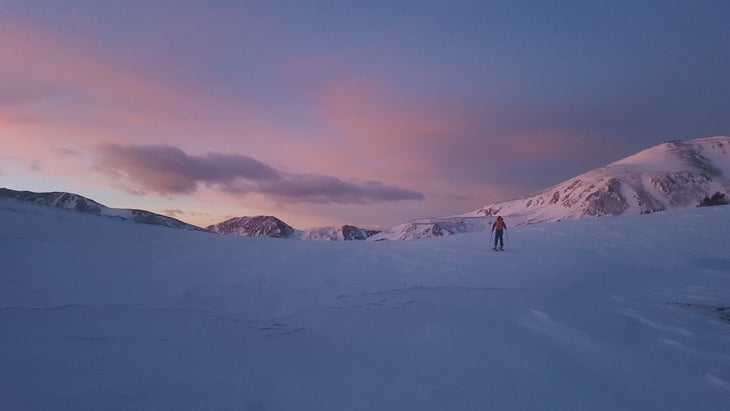Products You May Like
Receive $50 off an eligible $100 purchase at the Outside Shop, where you’ll find gear for all your adventures outdoors.
Sign up for Outside+ today.
“You’re clear!” my partner shouts. Or was it, “You’re not clear!”? Between the whipping wind and my pounding heart, my ears are picking up every third word. My skis hang over the edge of the cornice overlooking the central Tyndall Gorge in Rocky Mountain National Park. Below the drop-off, the narrow, near-vertical Dragon’s Tail couloir twists between granite spires like a bobsled track. Despite fantasizing about this exact moment for the few hours it took to climb here, my brain offers a final, firm protest against madness and gravity. Then, my partner gives the thumbs up, our signal that he’s in position to watch me (a safety precaution). My stomach drops. I take a deep breath and will myself forward a few long inches. Time to fly.
Objects in free fall accelerate at 9.8 meters per second. Squared. Thankfully, I land after a mere 4 feet—far less than my fear seemed to suggest—and suddenly my muscle memory kicks in. I send a series of quick turns through the rock garden to regain my balance and let my brain catch up with what’s happening. Speeding through the technical piece, my confidence surges and I remember how much I love skiing—fast. I streak down the 50-degree slope toward the chute, granite walls closing in around me. I fight the urge to kick a tail out to scrub speed—I didn’t spend my whole morning climbing this mountain to ease down the best part. In seconds, I skirt a corner around a jagged crag and the gully widens to 20 feet before it deposits me in the White Room.
Glee replaces nerves as I soar, arcing huge turns on the dreamy-soft, 30-degree face. When I cruise to a stop on the frozen lake, I topple over into a cloud of golden spindrift, giggling like an idiot.

A skier since I was five with a relatively newfound zeal for hiking, I nearly defected completely from the traffic-choked world of resort skiing when I discovered its backcountry superior a few years ago. What better way to maximize winter than to take the best of hiking—solitude, exercise, exploration, scenery—and combine it with skiing? There’s a sort of humility required in the sport that drew me in, too, because there aren’t patrol teams managing risk for you in the backcountry. You need to manage your own, carefully, through route-planning, studying the snowpack, waiting for the weather to align just right, and trusting your partner. I appreciated the reminder about the power of wilderness, so, two winters ago, I bought climbing skins, touring bindings, and safety equipment (all of which you can rent), to transform my resort setup into a backcountry-ready system.
My first tour involved a 5-mile skin to a broad, 25-degree slope—the equivalent of a resort green-circle run. It didn’t matter, though. The anticipation of plowing my own tracks through ungroomed snow drove me up the mountain (a physical effort that fends off cold toes even down to -25°F, in my experience).
Today, we skinned 3 miles covering some 3,500 feet of elevation gain to finally send the Dragon’s Tail. By most counts, the exchange rate in backcountry skiing is poor. For every descent, you owe the mountain gods a demanding, hours-long cardio workout. In return, you get lonely, often untracked slopes.
We pushed the pace through the spruce and fir forest so we might be able to lap the descent before the afternoon (when the sun often bakes the snowpack into avalanche-prone slabs) and reached Emerald Lake before 7 a.m. In summer, it’s a turquoise pool seated below Flattop Mountain’s granite, diadem-like spires; but today, it’s a staging area below some of the state’s most dramatic couloirs. They can hold more than 20 feet of snow.
We’d already ascended 800 feet, but we needed to triple that in the next half-mile. I started up the mountain, cutting a trail through the snow. Lifting my heel, I dragged my leg forward while maintaining as much of my ski’s skin-covered base on the snow’s surface as possible for traction. By the time I stood below the granite corridor, the sunshine painted the walls a brilliant orange. I clicked out of my bindings and strapped my skis to my pack—the slope above was too steep for skinning. I could have turned around and cruised down the 30-degree white apron, slashing turns in the pristine slope, and it’d still be worth it. But, I’d been meditating on the 50-degree couloir for the entire climb, so I kick-stepped up the chute.
At the top, I began shivering, but I wasn’t cold. I inched to the lip of the cornice and breathed. My partner gave the signal.
Time to fly.
